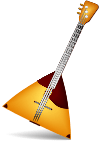Svirel
Swirel (Russian: свирель) is an old folk Russian wind instrument of the end-blown flute type. Classification: Aerophone-Whistle Flute-recorder.[1] In the Old Rus' this instrument was made either of hollow reed or cylindrical wood branches. A legend says that Lel', son of the Slavic goddess of love Lada was a svirel player. In spring he would make his svirel of birch branches.
Traditional Russian svirel has not yet been studied well enough. Specialists have long tried to relate the present day’s pipe instruments to their Old Russian names. Most often the chroniclers used three names for this type instruments: svirel, sopel (sopilka) and tsevnitsa.
Construction
Svirel is a simple wooden (sometimes metal) pipe. On the upper end it has a beak-like whistle device and in the middle of the face side it has several (usually six) finger-holes cut out. Wooden pipe is made of buckthorn, hazel, maple, ash tree, or bird cherry tree.
Etymology
The word svirel is obviously older than sopel, since it can be found in the Common Slavonic language and, consequently, it had existed in the epoch preceding the division of this language into the Eastern, Western and Southern branches. Yet, it is difficult to say whether this name referred to a definite kind of instrument: in the Old Rus’ any wind instrument player but for horn or trumpet players was called svirets or sviryanin.
History
So, svirel playing traditions of the Russians seem to be much older than the epoch of the Eastern Slavic community. Two such pipes were found during archeological excavations of the Old Novgorod in 1951-1962. One of them dating back to the late 11th century is 22.5 cm (approximately 9 inches) long and has four finger-holes. The second pipe dating to the early 15th century is 19 cm (approximately 7.5 inches) long and has only three holes.
However, it is difficult to say whether the Old Russian svirel was a double or a single pipe: there is no data about this preserved. What makes things still more complicated is the fact that names of similar instruments of kindred nations, such as Russians, Ukrainians and Belarusians are often mixed. N. I. Privalov fixed the name svirel to the double pipe, because this is how the instrument was called in Smolensk region, the major area of its popularity. This being the case the single svirel came to be called sopel. Nowadays svirel is more and more often referred to the end-blown flute type instrument with a whistle device nested into its upper part.
Playing technique
Double svirel has two similar pipes of different lengths. Each of the pipes has a whistle and three finger-holes. Size of the double svirel varies on a great scale. The bigger pipe can be 29 to 47 cm long, and the smaller 22 to 35 cm. The big pipe is usually held in the right hand and the small one in the left hand.
Bringing together two pipes into one instrument makes it possible for one player to perform two-voice melodies. The repertoire of double svirel tunes is quite extensive and versatile. Double svirel was unevenly spread in Russia. In the early 20th century Vasily Andreyev introduced into his orchestra svirels with key mechanism. Instruments of such construction still can be found in modern folk music orchestras.[2]
References
- ↑ "Svirel". The Metropolitan Museum of Art.
- ↑ "Svirel, Ancient Russian Pipe". www.russia-ic.com.
